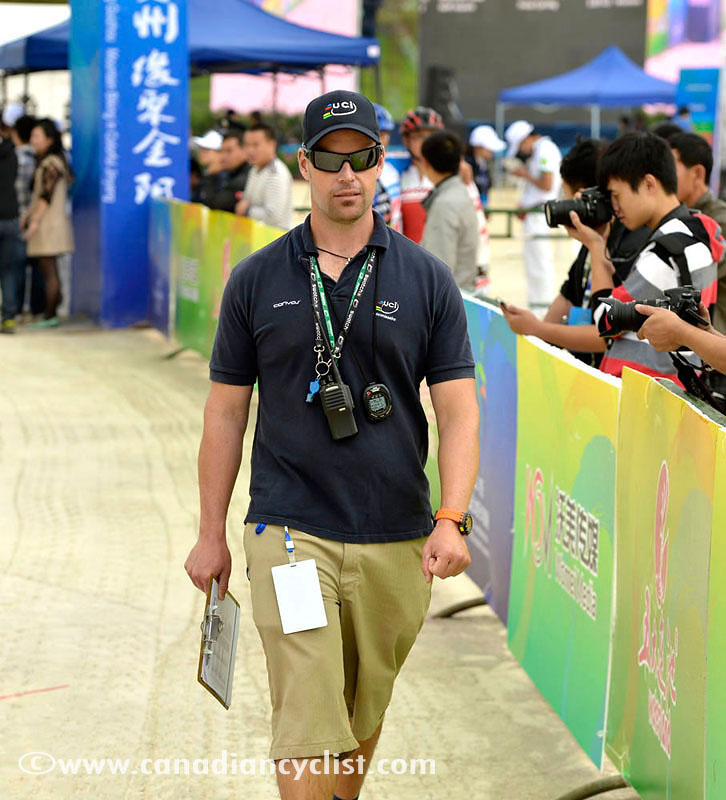February 26/13 10:53 am - The 80% Rule - What, Why, Where, When & How
Posted by Editoress on 02/26/13
CC correspondent Emil van Dijk decided to investigate the purpose behind the 80% rule in bike races.
At the 2013 cyclo-cross world championships in Louisville, Kentucky, officials strictly enforced the 80% rule. Introduced in 2010, the rule is applied in UCI-sanctioned cyclo-cross and cross-country mountain bike races, and provides a mechanism to remove from competition the slower riders who are on the verge of being lapped.
Purpose
According to UCI international commissaire Kevin MacCuish, the 80% rule is “an essential tool for managing the race.” He sees two primary reasons for its application:
“For major races, especially those that are televised, it is to avoid the situation where a rider is being lapped, or even worse, just about to be lapped, as the winner crosses the finish line. This can generate confusion among spectators and media as to who the winner and other riders on the podium are.”
Secondly, both cyclo-cross and Olympic format cross-country (XCO) mountain biking are held on relatively short circuits. The combination of a compressed course and a large field with divergent abilities can lead to the head of the race catching the tail. “In such situations the race leaders could very well be held up if they are caught behind slower riders in a narrow section of the course,” warns MacCuish.
To illustrate the second point, have a look at this bit of action from the 2009 cyclo-cross world cup race in Igorre, Spain . In attempting to answer a last-lap attack from Zdenek Stybar, Sven Nys runs into the back of lapped rider Ivar Hartogs, and promptly crashes. It can be argued that Nys may not have caught Stybar anyway, but the incident likely eased the way for Stybar’s eventual victory.
How It Works
As defined in the UCI regulations, the 80% rule reads the same for cyclo-cross as it does for XCO races: (A)ny rider whose time being 80 % slower of that of the race leader's first lap is pulled out of the race. He is required to leave the race at the end of his lap in the zone provided for the purpose (the "80 % zone") except when the rider is on his final lap.
In order to make this work, a commissaire (or two as was the case in Louisville), is stationed in the aforementioned 80% zone, which is usually a convenient point before the finish line, at a gap in the barriers where riders can easily exit the course. With stopwatch, pen and paper in hand, the commissaire notes the leader’s opening lap time, and then calculates what 80% of that time is.
As an easy example, if the leader’s first lap time is 10:00, then 80% of that would be 8:00. Should a rider fall 8:00 behind the leader, they are pulled from the race. The commissaire steps out onto the course, arms spread wide, and blows a whistle while signaling the rider in question to leave the course.
Under normal circumstances, it will take a while before anyone falls back far enough for the rule to be invoked. This means the commissaire has to continuously monitor the gap between the leader (who may not always be the same person from lap to lap) and those at the tail end of affairs.
Other Benefits
Cyclo-cross racer Craig Richey (SponsorConnected.com p/b Ridley Bikes) has seen both sides of the rule: “At Worlds or a World Cup a rider like myself has a high risk of getting pulled, but the 80% rule works to my advantage at North American UCI races where I am at the front of the race and would have to pass up to 40 riders if the 80% rule was not enforced.”

Craig Richey at 2013 Cross Worlds
The Victoria resident thinks the rule offers other benefits as well. Without the need to work through lapped riders, race leaders are not burdened with having to make passes that mid-pack riders would likely avoid, thereby making the competition fairer.
It also makes things a little safer in that fans are able to proceed to the awards presentation soon after the leaders finish. “In some big European races where I have made it onto the last lap I am often having to yell at spectators who are cutting the course to get to the awards presentation. This is dangerous for both the spectators and riders,” says Richey.
Long-time mountain bike race organizer Glenn Meeuwisse is in favour of using the 80% rule. “It’s a good framework. It keeps the racing clean for the leaders, and you can keep the day moving well. You can get awards going because you haven’t got someone who has to do another lap.”
Flexibility
Meeuwisse’s company, Pulse Racing, is running two UCI-sanctioned mountain bike races this summer. First up will be a Canada Cup in Sudbury, followed a week later by the national championships at Hardwood Ski & Bike, near Barrie. He anticipates that the 80% rule will be applied to the elite categories at both events.

With 13 years experience as a commissaire, MacCuish has officiated in both mountain bike and BMX disciplines at all levels, from local races to the 2012 Olympics in London. The BC resident agrees that for top-level events, the 80% rule is almost always applied, but that it isn’t a certainty.
“(F)or international C1 - C3 and national championships, I would say that it isn't a given that the 80% rule should always be used; it really depends more on the course and on the composition of the field. For lower-level international races that sort of straddle the boundary between professional events and "development" events, if there aren't that many riders and the course is longer with lots of passing opportunities, then there's a good chance I would decide not to use the 80% rule. To a certain point, when deciding whether or not to use the 80% rule, the level of the race matters a bit less than the particular circumstances of that race. But for top-level events (World Cups and world championships), it will always be used.”
Commissaire’s Discretion
Even if the 80% rule is not in effect, commissaires retain the power to remove slower riders if required.
“There is a general regulation applicable to all cycling disciplines that gives the commissaires the right to make any decisions they deem necessary to ensure smooth running of the race,” explains MacCuish. “If circumstances arose such that they decided it was best for (slower) riders to be removed, then they can do it whether the 80% rule is in force or not. The 80% rule is more an effort to provide a basic standard by which this removal of riders is done, so that there is some consistency from race to race.”
At races where the rule is invoked, its application can be modified, which occurs often in cyclo-cross. “The 80% rule is generally enforced much more liberally in Europe,” notes Richey. “As soon as you are more than four minutes or half a lap down there is a high likelihood that you will get pulled. In North America generally you have to be pretty close to getting lapped, something like close to 80% of a lap back before you will get pulled.”
MacCuish agrees that there is leeway in the rule’s application. “Depending upon the race situation, we may sometimes opt to leave riders in the race who, strictly speaking, have missed the 80% time, if it is unlikely that they will be lapped. More commonly, we might decide to be a little more aggressive in pulling lapped riders, particularly on short, fast courses when it should probably be more like 65% or 70%. Using a strict 80% of the leader's lap time in such circumstances virtually guarantees that there will be lapped riders, and, after all, the whole point of the 80% rule is to prevent any riders from being lapped.”
As an example, MacCuish points to the Guiyang International Mountain Bike Invitational, a World Cup test event held in September of last year in Guiyang, China. “The course was four kilometers exactly, and had a lot of climbing and some narrow sections. It also had everything from local riders to some in the top-10 of the UCI ranking. After the first lap we decided that we needed to knock at least 30 seconds off the 80% time and, even then, it still wasn't quite enough. In making decisions concerning situations like this, the general regulation (to make any decisions necessary to ensure the smooth running of the race) applies.”
Does The Rule Discourage Participation?
It is important to note that the 80% rule only applies to high-level elite races. “I would generally not want to see it used for provincial level events or for recreational categories for youth, or for adults (such as) sport, expert and masters,” cautions MacCuish, when asked if the rule discourages race participation.
“Even for lower-level international races, I believe that commissaires should be cautious when deciding to use the 80% rule. If the format of the course and composition of the field doesn't make its use necessary, then I always prefer to not use it for just this reason. Remember, the 80% rule is a tool intended to be used to manage international elite level races, that is, professional races. It isn't generally meant for use with non-elite categories.”
If you think that elite riders would be unconcerned about being pulled, consider Meeuwisse’s experience: “I’ve heard people say ' I’m not going to go in a race because I’m probably going to get lapped and I’m going to get pulled, so why should I pay to race if I’m not going to be able to complete the race? ' As an organizer of a higher-level race you know it may “scare some people away” because they know they’re going to get pulled because that’s part of the game. You can’t cater to everybody all the time."
Richey is philosophical of the effects of the rule on participation: “It discourages riders from racing above their level. If you can't finish on the lead lap at least some of the time when you have a clean race, then you are probably not in the right category or are doing races above your level.”
Results List
The manner in which pulled riders are listed in the final results can be confusing to the uninitiated. If a racer is pulled from the race with two laps remaining, the results will list their name and the notation " -2 ". The casual cycling fan may think the racer has been lapped twice, when in fact they were never lapped at all.
"Listing riders at -2 or however many laps they finished down is okay,” says Richey. “The racers know what this means, but family and fans checking results online often don't understand the 80% rule and don't know what -2 means. Some people have asked me what went wrong in the race assuming that -2 meant that I was lapped twice and in local races that is often what -2 does mean.”
“(T)he current method (of listing results) is probably the best method possible,” argues MacCuish. “Normally, those who are pulled are "going backwards" relative to the front of the race. They're listed in the order that they were pulled within each lap, which accurately reflects their position within the race at the time that they were pulled. Also, when you get into the last half of most any XCO race, you normally start to see very little change in the relative positions of the riders from lap to lap, especially at the back of the field. In most cases, the results for a race where the 80% rule is used would look very similar to the results if it wasn't used.”
“It is also important to realize that the only thing that matters when deciding the results of an XCO race is finish order, and not time. Time is a part of the results, but it does not in and of itself determine the outcome of the race. The order of the riders across the finish line decides the results. As the 80% rule lists riders in order of the number of laps they completed and then in the order that they were pulled within that lap, it does accurately reflect their efforts. They would have had pretty much the same position in the results whether they finished the race or were pulled from it.”
Asked for thoughts about an alternative method of listing results, Richey suggested “maybe something like "pulled at -2" or "80% at -2". I don't think this is something the UCI is worried about. They make money (from) Sven Nys putting on a good show at a televised World Cup, not how a pulled rider is listed in the results.”
| Return to Canadian Cyclist homepage | Back to Top |





